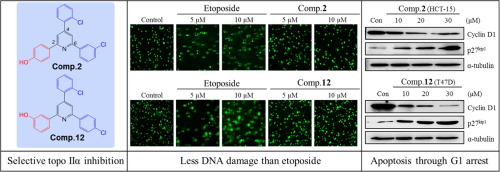Design, synthesis, biological evaluation, structure-activity relationship study, and mode of action of 2-phenol-4,6-dichlorophenyl-pyridines
Aarajana Shrestha, Seojeong Park, Somin Shin, Tara Man Kadayat, Ganesh Bist, Pramila Katila, Youngjoo Kwon, Eung-Seok Lee
Index: 10.1016/j.bioorg.2018.03.033
Full Text: HTML
Abstract

Human DNA topoisomerases (Topos) are essential nuclear enzyme whose level of expression is potential indicator for prediction of responsive result of chemotherapy. Topos has become a key cellular target for most of the anticancer agents that regulates topological problems of DNA during cellular metabolic processes such as replication, transcription, and recombination. Inspired by previous studies of 2,4,6-trisubstituted pyridines to find out safer and effective topoisomerase targeted anticancer agent, twenty-seven 2-phenol-4,6-dichlorophenyl-pyridines were designed, synthesized, and tested for their topo I and IIα inhibitory and anti-proliferative activity. Most of the dichlorinated meta- and para-phenolic series compounds (1-18) exhibited potent and selective topo IIα inhibition along with significant anti-proliferative activity in the HCT-15 and T47D cell lines compared to the positive control, etoposide. Interestingly, dichlorinated ortho-phenolic series compounds (19-27) exhibited potent and dual topo inhibition but very weak anti-proliferative activity in the tested cancer cell lines. Structure-activity relationship with previously synthesized compounds revealed the importance of chlorine moiety to improve the potency of topo inhibitory activity. Further mechanistic study confirmed that compounds 2 and 12 acted as non-intercalative specific topo IIα catalytic inhibitor with less DNA damage, and induced G1 arrest and apoptosis in HCT-15 and T47D cell lines, respectively.
|
Synthesis, biological evaluation and molecular docking studi...
2018-04-03 [10.1016/j.bioorg.2018.03.028] |
|
New advances in synthesis and clinical aspects of pyrazolo[3...
2018-04-03 [10.1016/j.bioorg.2018.03.032] |
|
Design, synthesis and evaluation of some pyrazolo[3,4-d]pyri...
2018-04-03 [10.1016/j.bioorg.2018.03.030] |
|
Synthesis and molecular docking study of piperazine derivati...
2018-03-30 [10.1016/j.bioorg.2018.03.026] |
|
Design, synthesis and in vitro evaluation of β-glucuronidase...
2018-03-30 [10.1016/j.bioorg.2018.03.020] |